A Comprehensive Overview of the Developments of Cdc25 Phosphatase Inhibitors
Abstract
:1. Introduction
2. Structure of Cdc25 Phosphatase
3. Mechanism of Dephosphorylation of Cdc25 Substrate
4. Cdc25 Phosphatases and Cancer
5. Molecular Studies of Cdc25 Phosphatase
6. Interaction between Cdc25 Phosphatase and Its Protein Substrate
7. Cdc25 Inhibitors
7.1. Cdc25 Inhibitors Based on the Quinoid Structure
| ID | Cdc25 Inhibitory | A549 | IC-2WT | HeLa | MiaPaCa-2 | MDA-MB-436 | PC-3 | ||
|---|---|---|---|---|---|---|---|---|---|
| A | B | C | |||||||
| 16 [36] | 0.5 ± 0.01 * | 0.21 ± 0.08 * | 0.47 ± 0.09 * | 1.48 ± 0.04 | 0.5 | 1 | |||
| 0.91 ± 0.36 * | |||||||||
| 17 [37] | 0.38 ± 0.06 | 1.8 ± 0.7 | 0.66 ± 0.27 | 0.1 | 0.8 | ||||
| 18 [38] | 0.5 ± 0.1 | 22.28 ± 0.62 | |||||||
| 19 [38] | 1.1 ± 0.1 | 2.69 ± 0.08 | |||||||
| 20 [38] | 5.3 ± 0.6 | 9.52 ± 0.33 | |||||||
| 21 [40,41] | 3.38 ± 0.62 | 6.7 ± 1.3 | 5.43 ± 1.22 | 0.34 | |||||
| 22 [40,41] | 1.51 ± 0.2 | 2.7 ± 0.5 | 2.68 ± 0.23 | 0.22 | |||||
| 23 [40,41] | 2.57 ± 0.60 | 5.4 ± 0.7 | 3.31 ± 0.28 | 0.28 | |||||
| 24 [40,41] | 4.89 ± 0.82 | 19.1 ± 0.3 | 10.8 ± 0.46 | 1.67 | |||||
| 25 [40,41] | 18.2 ± 1.13 | 32.5 ± 3.6 | 16.6 ± 0.98 | 0.03 | |||||
| 26 [40,41] | 0.01 | ||||||||
| 27 [33] | 13 ± 0.9 ** (10 µM) | 24 ± 15.4 ** (10 µM) | |||||||
| 79 ± 0.9 ** (100 µM) | 77 ± 2.1 ** (100 µM) | ||||||||
| 28 [42] | 0.15 ± 0.05 | 0.19 ± 0.06 | 0.06 ± 0.06 | ||||||
7.2. Cdc25 Inhibitors Based on Steroid and Dysidolide-like Compounds
7.3. Cdc25 Inhibitors Based on Glycosidic Structures
7.4. Miscellaneous Cdc25 Inhibitors
8. Computational Methods to Discover and Optimize Cdc25 Inhibitors
9. Conclusions
Author Contributions
Funding
Conflicts of Interest
Abbreviations
| Cdk/Cyc | Cyclin-dependent kinase |
| PTP1B | Protein tyrosine phosphatase 1B |
| PTPs | protein tyrosine phosphatases |
| DSPs | dual-specificity phosphatases |
| VHR | A dual specificity phosphatase, V accinia-H 1 R elated (VHR) phosphatase |
| RK-682 | (R)-3-Hexadecanoyl-5-hydroxymethyltetronic acid, (R)-4-Hydroxy-5-(hydroxyl-methyl)-3-(1-oxohexadecyl)-2(5H)-furanone |
| ROS | reactive oxygen species |
| SC-ααδ9 | 4-(Benzyl-(2-[(2,5-diphenyloxazole-4-carbonyl)amino]ethyl)carbamoyl)-2-decanoyl-aminobutyric acid |
| PP1 | Protein phosphatase 1 |
| PP2A | Protein phosphatase 2 |
| PP3 | Protein phosphatase 3 |
| FY21-αα09 | 2-(Decanoylamino)-5-[[(1β)-4α-[[(2,5-diphenyl-4-oxazolyl)carbonyl]amino]cyclo-hexyl]amino]-5-oxopentanoic acid |
| BN82002 | 4-(dimethylamino)-2-methoxy-6-[[methyl-[2-(4-nitrophenyl) ethyl] amino] methyl]phenol |
| NIH | National Institutes of Health |
| MKP | Mitogen-activated protein kinase phosphatase |
| XDW-1 | 2-(4-(4-chlorophenyl)-5-p-tolyl-4H-1,2,4-triazol-3-ylthio)-1-(3,4-dihydroxyphenyl) ethanone |
| VK3 | vitamin K3 |
References
- Parks, J.M.; Hu, H.; Rudolph, J.; Yang, W. Mechanism of Cdc25B Phosphatase with the Small Molecule Substrate P-Nitrophenyl Phosphate from QM/MM-MFEP Calculations. J. Phys. Chem. B 2009, 113, 5217–5224. [Google Scholar] [CrossRef] [PubMed] [Green Version]
- Kim, K.-R.; Kwon, J.-L.; Kim, J.-S.; No, Z.; Kim, H.R.; Cheon, H.G. EK-6136 (3-Methyl-4-(O-Methyl-Oximino)-1-Phenylpyrazolin-5-One): A Novel Cdc25B Inhibitor with Antiproliferative Activity. Eur. J. Pharmacol. 2005, 528, 37–42. [Google Scholar] [CrossRef] [PubMed]
- Hoffmann, I.; Karsenti, E. The Role of Cdc25 in Checkpoints and Feedback Controls in the Eukaryotic Cell Cycle. J. Cell Sci. 1994, 1994, 75–79. [Google Scholar] [CrossRef] [PubMed] [Green Version]
- Hoffmann, I. The Role of Cdc25 Phosphatases in Cell Cycle Checkpoints. Protoplasma 2000, 211, 8–11. [Google Scholar] [CrossRef]
- Cairns, J.; Ly, R.C.; Niu, N.; Kalari, K.R.; Carlson, E.E.; Wang, L. CDC25B Partners with PP2A to Induce AMPK Activation and Tumor Suppression in Triple Negative Breast Cancer. NAR Cancer 2020, 2, 39. [Google Scholar] [CrossRef]
- Rudolph, J. Cdc25 Phosphatases: Structure, Specificity, and Mechanism. Biochemistry 2007, 46, 3595–3604. [Google Scholar] [CrossRef]
- Boutros, R.; Dozier, C.; Ducommun, B. The When and Wheres of CDC25 Phosphatases. Curr. Opin. Cell Biol. 2006, 18, 185–191. [Google Scholar] [CrossRef]
- Liu, K.; Zheng, M.; Lu, R.; Du, J.; Zhao, Q.; Li, Z.; Li, Y.; Zhang, S. The Role of CDC25C in Cell Cycle Regulation and Clinical Cancer Therapy: A Systematic Review. Cancer Cell. Int. 2020, 20, 213. [Google Scholar] [CrossRef]
- Holmes, T.R.; Al-Matouq, J.; Holmes, M.; Nicola, L.; Rudd, J.C.; Lovas, S.; Hansen, L.A. Targeting 14-3-3ε-CDC25A Interactions to Trigger Apoptotic Cell Death in Skin Cancer. Oncotarget 2020, 11, 3267–3278. [Google Scholar] [CrossRef]
- Ham, S.W.; Park, J.; Lee, S.J.; Kim, W.; Kang, K.; Choi, K.H. Naphthoquinone Analogs as Inactivators of Cdc25 Phosphatase. Bioorg. Med. Chem. Lett. 1998, 8, 2507–2510. [Google Scholar] [CrossRef]
- Wu, F.Y.; Sun, T.P. Vitamin K3 Induces Cell Cycle Arrest and Cell Death by Inhibiting Cdc25 Phosphatase. Eur. J. Cancer 1999, 35, 1388–1393. [Google Scholar] [CrossRef]
- Lavecchia, A.; Di Giovanni, C.; Novellino, E. Inhibitors of Cdc25 Phosphatases as Anticancer Agents: A Patent Review. Expert Opin. Ther. Pat. 2010, 20, 405–425. [Google Scholar] [CrossRef]
- Rudolph, J. Catalytic Mechanism of Cdc25. Biochemistry 2002, 41, 14613–14623. [Google Scholar] [CrossRef]
- Sohn, J.; Rudolph, J. Catalytic and Chemical Competence of Regulation of Cdc25 Phosphatase by Oxidation/Reduction. Biochemistry 2003, 42, 10060–10070. [Google Scholar] [CrossRef]
- Gao, X.; Wang, Q.; Wang, Y.; Liu, J.; Liu, S.; Liu, J.; Zhou, X.; Zhou, L.; Chen, H.; Pan, L.; et al. The REGγ Inhibitor NIP30 Increases Sensitivity to Chemotherapy in P53-Deficient Tumor Cells. Nat. Commun. 2020, 11, 3904. [Google Scholar] [CrossRef]
- Sur, S.; Agrawal, D.K. Phosphatases and Kinases Regulating CDC25 Activity in the Cell Cycle: Clinical Implications of CDC25 Overexpression and Potential Treatment Strategies. Mol. Cell Biochem. 2016, 416, 33–46. [Google Scholar] [CrossRef] [Green Version]
- Boutros, R.; Lobjois, V.; Ducommun, B. CDC25 Phosphatases in Cancer Cells: Key Players? Good Targets? Nat. Rev. Cancer 2007, 7, 495–507. [Google Scholar] [CrossRef]
- Rudolph, J. Targeting the Neighbor’s Pool. Mol. Pharmacol. 2004, 66, 780–782. [Google Scholar] [CrossRef] [Green Version]
- Kristjánsdóttir, K.; Rudolph, J. Cdc25 Phosphatases and Cancer. Chem. Biol. 2004, 11, 1043–1051. [Google Scholar] [CrossRef] [Green Version]
- Sohn, J.; Parks, J.M.; Buhrman, G.; Brown, P.; Kristjánsdóttir, K.; Safi, A.; Edelsbrunner, H.; Yang, W.; Rudolph, J. Experimental Validation of the Docking Orientation of Cdc25 with Its Cdk2-CycA Protein Substrate. Biochem. J. 2005, 44, 16563–16573. [Google Scholar] [CrossRef]
- Reynolds, R.A.; Yem, A.W.; Wolfe, C.L.; Deibel, M.R.; Chidester, C.G.; Watenpaugh, K.D. Crystal Structure of the Catalytic Subunit of Cdc25B Required for G2/M Phase Transition of the Cell Cycle11Edited by I. A. Wilson. J. Mol. Biol. 1999, 293, 559–568. [Google Scholar] [CrossRef]
- Rudolph, J.; Epstein, D.M.; Parker, L.; Eckstein, J. Specificity of Natural and Artificial Substrates for Human Cdc25A. Anal. Biochem. 2001, 289, 43–51. [Google Scholar] [CrossRef]
- Borgne-Sanchez, A.; Meijer, L. Sequential Dephosphorylation of P34cdc2 on Thr-14 and Tyr-15 at the Prophase/Metaphase Transition. J. Biol. Chem. 1996, 271, 27847–27854. [Google Scholar] [CrossRef] [Green Version]
- Tao, Y.; Hao, X.; Ding, X.; Cherukupalli, S.; Song, Y.; Liu, X.; Zhan, P. Medicinal Chemistry Insights into Novel CDC25 Inhibitors. Eur. J. Med. Chem. 2020, 201, 112374. [Google Scholar] [CrossRef]
- Markovits, J.; Wang, Z.; Carr, B.I.; Sun, T.P.; Mintz, P.; Le Bret, M.; Wu, C.-W.; Wu, F.Y.-H. Differential Effects of Two Growth Inhibitory K Vitamin Analogs on Cell Cycle Regulating Proteins in Human Hepatoma Cells. Life Sci. 2003, 72, 2769–2784. [Google Scholar] [CrossRef]
- Peyregne, V.P.; Kar, S.; Ham, S.W.; Wang, M.; Wang, Z.; Carr, B.I. Novel Hydroxyl Naphthoquinones with Potent Cdc25 Antagonizing and Growth Inhibitory Properties. Mol. Cancer Ther. 2005, 4, 595–602. [Google Scholar] [CrossRef] [Green Version]
- Kar, S.; Wang, M.; Ham, S.W.; Carr, B.I. Fluorinated Cpd 5, a Pure Arylating K-Vitamin Derivative, Inhibits Human Hepatoma Cell Growth by Inhibiting Cdc25 and Activating MAPK. Biochem. Pharmacol. 2006, 72, 1217–1227. [Google Scholar] [CrossRef] [PubMed]
- Wang, Z.; Southwick, E.C.; Wang, M.; Kar, S.; Rosi, K.S.; Wilcox, C.S.; Lazo, J.S.; Carr, B.I. Involvement of Cdc25A Phosphatase in Hep3B Hepatoma Cell Growth Inhibition Induced by Novel K Vitamin Analogs. Cancer Res. 2001, 61, 7211–7216. [Google Scholar] [PubMed]
- Kar, S.; Lefterov, I.M.; Wang, M.; Lazo, J.S.; Scott, C.N.; Wilcox, C.S.; Carr, B.I. Binding and Inhibition of Cdc25 Phosphatases by Vitamin K Analogues. Biochemistry 2003, 42, 10490–10497. [Google Scholar] [CrossRef] [PubMed]
- Brun, M.-P.; Braud, E.; Angotti, D.; Mondésert, O.; Quaranta, M.; Montes, M.; Miteva, M.; Gresh, N.; Ducommun, B.; Garbay, C. Design, Synthesis, and Biological Evaluation of Novel Naphthoquinone Derivatives with CDC25 Phosphatase Inhibitory Activity. Bioorgan. Med. Chem. 2005, 13, 4871–4879. [Google Scholar] [CrossRef] [PubMed]
- Shimbashi, A.; Tsuchiya, A.; Imoto, M.; Nishiyama, S. Synthesis of the Naphthalene-Derived Inhibitors against Cdc25A Dual-Specificity Protein Phosphatase and Their Biological Activity. Bioorg. Med. Chem. Lett. 2005, 15, 61–65. [Google Scholar] [CrossRef]
- Braud, E.; Goddard, M.; Kolb, S.; Brun, M.-P.; Mondésert, O.; Quaranta, M.; Gresh, N.; Ducommun, B.; Garbay, C. Novel Naphthoquinone and Quinolinedione Inhibitors of CDC25 Phosphatase Activity with Antiproliferative Properties. Bioorgan. Med. Chem. 2008, 16, 9040–9049. [Google Scholar] [CrossRef]
- Besset, T.; Braud, E.; Jarray, R.; Garbay, C.; Kolb, S.; Leo, P.-M.; Morin, C. Preparation and Evaluation of a Set of Bis(Methoxycarbonylmethylthio) Heteroquinones as CDC25B Phosphatase Inhibitors. Eur. J. Chem. 2011, 2, 433–440. [Google Scholar] [CrossRef] [Green Version]
- Bana, E.; Sibille, E.; Valente, S.; Cerella, C.; Chaimbault, P.; Kirsch, G.; Dicato, M.; Diederich, M.; Bagrel, D. A Novel Coumarin-Quinone Derivative SV37 Inhibits CDC25 Phosphatases, Impairs Proliferation, and Induces Cell Death. Mol. Carcinog 2015, 54, 229–241. [Google Scholar] [CrossRef]
- Sibille, E.; Bana, E.; Chaouni, W.; Diederich, M.; Bagrel, D.; Chaimbault, P. Development of a Matrix-Assisted Laser Desorption/Ionization-Mass Spectrometry Screening Test to Evidence Reversible and Irreversible Inhibitors of CDC25 Phosphatases. Anal. Biochem. 2012, 430, 83–91. [Google Scholar] [CrossRef]
- Lazo, J.S.; Aslan, D.C.; Southwick, E.C.; Cooley, K.A.; Ducruet, A.P.; Joo, B.; Vogt, A.; Wipf, P. Discovery and Biological Evaluation of a New Family of Potent Inhibitors of the Dual Specificity Protein Phosphatase Cdc25. J. Med. Chem. 2001, 44, 4042–4049. [Google Scholar] [CrossRef]
- Brisson, M.; Nguyen, T.; Wipf, P.; Joo, B.; Day, B.W.; Skoko, J.S.; Schreiber, E.M.; Foster, C.; Bansal, P.; Lazo, J.S. Redox Regulation of Cdc25B by Cell-Active Quinolinediones. Mol. Pharmacol. 2005, 68, 1810–1820. [Google Scholar] [CrossRef]
- Keinan, S.; Paquette, W.D.; Skoko, J.J.; Beratan, D.N.; Yang, W.; Shinde, S.; Johnston, P.A.; Lazo, J.S.; Wipf, P. Computational Design, Synthesis and Biological Evaluation of Para-Quinone-Based Inhibitors for Redox Regulation of the Dual-Specificity Phosphatase Cdc25B. Org. Biomol. Chem. 2008, 6, 3256–3263. [Google Scholar] [CrossRef]
- Wipf, P.; Joo, B.; Nguyen, T.; Lazo, J.S. Synthesis and Biological Evaluation of Caulibugulones A–E. Org. Biomol. Chem. 2004, 2, 2173–2174. [Google Scholar] [CrossRef]
- Milanowski, D.J.; Gustafson, K.R.; Kelley, J.A.; McMahon, J.B. Caulibugulones A-F, Novel Cytotoxic Isoquinoline Quinones and Iminoquinones from the Marine Bryozoan Caulibugula Intermis. J. Nat. Prod. 2004, 67, 70–73. [Google Scholar] [CrossRef]
- Brisson, M.; Foster, C.; Wipf, P.; Joo, B.; Tomko, R.J.; Nguyen, T.; Lazo, J.S. Independent Mechanistic Inhibition of Cdc25 Phosphatases by a Natural Product Caulibugulone. Mol. Pharmacol. 2007, 71, 184–192. [Google Scholar] [CrossRef]
- Tao, Y.; Hao, X.; Jing, L.; Sun, L.; Cherukupalli, S.; Liu, S.; Wu, G.; Xu, S.; Zhang, X.; Shi, X.; et al. Discovery of Potent and Selective Cdc25 Phosphatase Inhibitors via Rapid Assembly and in Situ Screening of Quinonoid-Focused Libraries. Bioorg. Chem. 2021, 115, 105254. [Google Scholar] [CrossRef]
- Huang, W.G.; Jiang, Y.Y.; Li, Q.; Li, J.; Li, J.Y.; Lu, W.; Cai, J.C. Synthesis and Biological Evaluation of (±)-Cryptotanshinone and Its Simplified Analogues as Potent CDC25 Inhibitors. Tetrahedron 2005, 61, 1863–1870. [Google Scholar] [CrossRef]
- Huang, W.; Li, J.; Luo, Y.; Li, J.; Lu, W. Synthesis of Tanshinone IIA Analogues and Their Inhibitory Activities against Cdc25 Phosphatases. Chin. Chem. Lett. 2009, 20, 1461–1464. [Google Scholar] [CrossRef]
- Brisson, M.; Nguyen, T.; Vogt, A.; Yalowich, J.; Giorgianni, A.; Tobi, D.; Bahar, I.; Stephenson, C.R.J.; Wipf, P.; Lazo, J.S. Discovery and Characterization of Novel Small Molecule Inhibitors of Human Cdc25B Dual Specificity Phosphatase. Mol. Pharmacol. 2004, 66, 824–833. [Google Scholar] [CrossRef] [Green Version]
- Otani, T.; Sugimoto, Y.; Aoyagi, Y.; Igarashi, Y.; Furumai, T.; Saito, N.; Yamada, Y.; Asao, T.; Oki, T. New Cdc25B Tyrosine Phosphatase Inhibitors, Nocardiones A and B, Produced by Nocardia Sp. TP-A0248: Taxonomy, Fermentation, Isolation, Structural Elucidation and Biological Properties. J. Antibiot. 2000, 53, 337–344. [Google Scholar] [CrossRef] [Green Version]
- Huang, W.; Li, J.; Zhang, W.; Zhou, Y.; Xie, C.; Luo, Y.; Li, Y.; Wang, J.; Li, J.; Lu, W. Synthesis of Miltirone Analogues as Inhibitors of Cdc25 Phosphatases. Bioorg. Med. Chem. Lett. 2006, 16, 1905–1908. [Google Scholar] [CrossRef] [PubMed]
- Lazo, J.S.; Nemoto, K.; Pestell, K.E.; Cooley, K.; Southwick, E.C.; Mitchell, D.A.; Furey, W.; Gussio, R.; Zaharevitz, D.W.; Joo, B.; et al. Identification of a Potent and Selective Pharmacophore for Cdc25 Dual Specificity Phosphatase Inhibitors. Mol. Pharmacol. 2002, 61, 720–728. [Google Scholar] [CrossRef] [PubMed]
- Wipf, P.; Hopkins, C.R.; Phillips, E.O.; Lazo, J.S. Separation of Cdc25 Dual Specificity Phosphatase Inhibition and DNA Cleaving Activities in a Focused Library of Analogs of the Antitumor Antibiotic Dnacin. Tetrahedron 2002, 58, 6367–6372. [Google Scholar] [CrossRef]
- Kulanthaivel, P.; Perun, T.J.; Belvo, M.D.; Strobel, R.J.; Paul, D.C.; Williams, D.C. Novel Naphthoquinones from a Streptomyces sp. J. Antibiot. 1999, 52, 256–262. [Google Scholar] [CrossRef] [Green Version]
- Cao, S.; Foster, C.; Brisson, M.; Lazo, J.S.; Kingston, D.G.I. Halenaquinone and Xestoquinone Derivatives, Inhibitors of Cdc25B Phosphatase from a Xestospongia sp. Bioorg. Med. Chem. 2005, 13, 999–1003. [Google Scholar] [CrossRef]
- Cao, S.; Murphy, B.T.; Foster, C.; Lazo, J.S.; Kingston, D.G.I. Bioactivities of Simplified Adociaquinone B and Naphthoquinone Derivatives against Cdc25B, MKP-1, and MKP-3 Phosphatases. Bioorg. Med. Chem. 2009, 17, 2276–2281. [Google Scholar] [CrossRef] [Green Version]
- Brezak, M.-C.; Quaranta, M.; Contour-Galcera, M.-O.; Lavergne, O.; Mondesert, O.; Auvray, P.; Kasprzyk, P.G.; Prevost, G.P.; Ducommun, B. Inhibition of Human Tumor Cell Growth in Vivo by an Orally Bioavailable Inhibitor of CDC25 Phosphatases. Mol. Cancer Ther. 2005, 4, 1378–1387. [Google Scholar] [CrossRef] [Green Version]
- Brezak, M.-C.; Valette, A.; Quaranta, M.; Contour-Galcera, M.-O.; Jullien, D.; Lavergne, O.; Frongia, C.; Bigg, D.; Kasprzyk, P.G.; Prevost, G.P.; et al. IRC-083864, a Novel Bis Quinone Inhibitor of CDC25 Phosphatases Active against Human Cancer Cells. Int. J. Cancer 2009, 124, 1449–1456. [Google Scholar] [CrossRef]
- Valente, S.; Xu, Z.; Bana-Evain, E.; Zwergel, C.; Mai, A.; Jacob, C.; Meiser, P.; Bagrel, D.; Silva, A.; Kirsch, G. Reactivity of 4-Vinyl-2H-1-Benzopyran-2-Ones in Diels–Alder Cycloaddition Reactions: Access to Coumarin-Based Polycycles with Cdc25 Phosphatase-Inhibiting Activity. Eur. J. Org. Chem. 2013, 2013, 2869–2877. [Google Scholar] [CrossRef]
- Sarkis, M.; Tran, D.N.; Kolb, S.; Miteva, M.A.; Villoutreix, B.O.; Garbay, C.; Braud, E. Design and Synthesis of Novel Bis-Thiazolone Derivatives as Micromolar CDC25 Phosphatase Inhibitors: Effect of Dimerisation on Phosphatase Inhibition. Bioorg. Med. Chem Lett. 2012, 22, 7345–7350. [Google Scholar] [CrossRef]
- Kar, S.; Wang, M.; Ham, S.W.; Carr, B.I. H32, a Non-Quinone Sulfone Analog of Vitamin K3, Inhibits Human Hepatoma Cell Growth by Inhibiting Cdc25 and Activating ERK. Cancer Biol. Ther. 2006, 5, 1340–1347. [Google Scholar] [CrossRef] [Green Version]
- Choi, S.-M.; Han, J.-S.; Park, S.-H.; Ham, S.-W. Non-Quinone Sulfone Analog as a Cdc25 Inhibitor: Biological Evaluation and Structural Determinants of Cdc25A and Cdc25B Selectivity. Bull. Korean Chem. Soc. 2008, 29, 1659–1660. [Google Scholar] [CrossRef] [Green Version]
- Sohn, J.; Kiburz, B.; Li, Z.; Deng, L.; Safi, A.; Pirrung, M.C.; Rudolph, J. Inhibition of Cdc25 Phosphatases by Indolyldihydroxyquinones. J. Med. Chem. 2003, 46, 2580–2588. [Google Scholar] [CrossRef]
- El-Subbagh, H.I.; Abadi, A.H.; al-Khawad, I.E.; al-Rashood, K.A. Synthesis and Antitumor Activity of Some New Substituted Quinolin-4-One and 1,7-Naphthyridin-4-One Analogs. Arch. Pharm. 1999, 332, 19–24. [Google Scholar] [CrossRef]
- Gunasekera, S.P.; McCarthy, P.J.; Kelly-Borges, M.; Lobkovsky, E.; Clardy, J. Dysidiolide: A Novel Protein Phosphatase Inhibitor from the Caribbean Sponge Dysidea Etheria de Laubenfels. J. Am. Chem. Soc. 1996, 118, 8759–8760. [Google Scholar] [CrossRef]
- Peng, H.; Zalkow, L.H.; Abraham, R.T.; Powis, G. Novel CDC25A Phosphatase Inhibitors from Pyrolysis of 3-Alpha-Azido-B-Homo-6-Oxa-4-Cholesten-7-One on Silica Gel. J. Med. Chem 1998, 41, 4677–4680. [Google Scholar] [CrossRef]
- Blanchard, J.L.; Epstein, D.M.; Boisclair, M.D.; Rudolph, J.; Pal, K. Dysidiolide and Related Gamma-Hydroxy Butenolide Compounds as Inhibitors of the Protein Tyrosine Phosphatase, CDC25. Bioorg. Med. Chem. Lett. 1999, 9, 2537–2538. [Google Scholar] [CrossRef]
- Takahashi, M.; Dodo, K.; Sugimoto, Y.; Aoyagi, Y.; Yamada, Y.; Hashimoto, Y.; Shirai, R. Synthesis of the Novel Analogues of Dysidiolide and Their Structure-Activity Relationship. Bioorg. Med. Chem. Lett. 2000, 10, 2571–2574. [Google Scholar] [CrossRef]
- Peng, H.; Xie, W.; Kim, D.I.; Zalkow, L.H.; Powis, G.; Otterness, D.M.; Abraham, R.T. Steroidal Derived Acids as Inhibitors of Human Cdc25A Protein Phosphatase. Bioorg. Med. Chem. 2000, 8, 299–306. [Google Scholar] [CrossRef]
- Peng, H.; Xie, W.; Otterness, D.M.; Cogswell, J.P.; McConnell, R.T.; Carter, H.L.; Powis, G.; Abraham, R.T.; Zalkow, L.H. Syntheses and Biological Activities of a Novel Group of Steroidal Derived Inhibitors for Human CDC25A Protein Phosphatase. J. Med. Chem. 2001, 44, 834–848. [Google Scholar] [CrossRef]
- Peng, H.; Otterness, D.M.; Abraham, R.T.; Zalkow, L.H. Cdc25A Protein Phosphatase Inhibitors from Anomalous Ozonolysis of 5,6-Seco-5-Oxo-3-Cholesten-6-Oic Acid. Tetrahedron 2001, 57, 1891–1896. [Google Scholar] [CrossRef]
- Brohm, D.; Metzger, S.; Bhargava, A.; Müller, O.; Lieb, F.; Waldmann, H. Natural Products Are Biologically Validated Starting Points in Structural Space for Compound Library Development: Solid-Phase Synthesis of Dysidiolide-Derived Phosphatase Inhibitors. Angew. Chem. Int. Ed. Engl. 2002, 41, 307–311. [Google Scholar] [CrossRef]
- Dodo, K.; Takahashi, M.; Yamada, Y.; Sugimoto, Y.; Hashimoto, Y.; Shirai, R. Synthesis of a Novel Class of Cdc25A Inhibitors from Vitamin D3. Bioorg. Med. Chem. Lett. 2000, 10, 615–617. [Google Scholar] [CrossRef]
- Shimazawa, R.; Suzuki, T.; Dodo, K.; Shirai, R. Design and Synthesis of Dysidiolide Analogs from Vitamin D3: Novel Class of Cdc25A Inhibitors. Bioorg. Med. Chem. Lett. 2004, 14, 3291–3294. [Google Scholar] [CrossRef]
- Shimazawa, R.; Gochomori, M.; Shirai, R. Design and Synthesis of Novel Cdc25A-Inhibitors Having Phosphate Group as a Hydrophilic Residue. Bioorg Med. Chem Lett 2004, 14, 4339–4342. [Google Scholar] [CrossRef] [PubMed]
- Shimazawa, R.; Kuriyama, M.; Shirai, R. Design and Synthesis of N-Alkyl Oxindolylidene Acetic Acids as a New Class of Potent Cdc25A Inhibitors. Bioorg. Med. Chem. Lett. 2008, 18, 3350–3353. [Google Scholar] [CrossRef] [PubMed]
- Brault, L.; Bagrel, D. Activity of Novel Cdc25 Inhibitors and Preliminary Evaluation of Their Potentiation of Chemotherapeutic Drugs in Human Breast Cancer Cells. Life Sci. 2008, 5–6, 315–323. [Google Scholar] [CrossRef] [PubMed]
- Brault, L.; Denancé, M.; Banaszak, E.; El Maadidi, S.; Battaglia, E.; Bagrel, D.; Samadi, M. Synthesis and Biological Evaluation of Dialkylsubstituted Maleic Anhydrides as Novel Inhibitors of Cdc25 Dual Specificity Phosphatases. Eur. J. Med. Chem. 2007, 42, 243–247. [Google Scholar] [CrossRef] [PubMed]
- Loukaci, A.; Le Saout, I.; Samadi, M.; Leclerc, S.; Damiens, E.; Meijer, L.; Debitus, C.; Guyot, M. Coscinosulfate, a CDC25 Phosphatase Inhibitor from the Sponge Coscinoderma Mathewsi. Bioorg. Med. Chem. 2001, 9, 3049–3054. [Google Scholar] [CrossRef]
- Kar, S.; Wang, M.; Carr, B.I. 2-Methoxyestradiol Inhibits Hepatocellular Carcinoma Cell Growth by Inhibiting Cdc25 and Inducing Cell Cycle Arrest and Apoptosis. Cancer Chemother. Pharmacol. 2008, 62, 831–840. [Google Scholar] [CrossRef]
- Yang, J.-W.; He, X.-P.; Li, C.; Gao, L.-X.; Sheng, L.; Xie, J.; Shi, X.-X.; Tang, Y.; Li, J.; Chen, G.-R. A Unique and Rapid Approach toward the Efficient Development of Novel Protein Tyrosine Phosphatase (PTP) Inhibitors Based on “clicked” Pseudo-Glycopeptides. Bioorg. Med. Chem. Lett. 2011, 21, 1092–1096. [Google Scholar] [CrossRef]
- Huang, B.; Ma, Y.; Xiong, Z.; Lu, W.; Ding, R.; Li, T.; Jiang, P.; Liang, M. Facile Fabrication of Ir/CNT/RGO Nanocomposites with Enhanced Electrocatalytic Performance for the Hydrogen Evolution Reaction. Sustain. Energy Fuels 2020, 4, 3288–3292. [Google Scholar] [CrossRef]
- He, X.-P.; Li, C.; Wang, Z.-Z.; Gao, L.-X.; Shi, X.-X.; Tang, Y.; Xie, J.; Li, J.; Chen, G.-R.; Chen, K. Discovering the Distinct Inhibitory Effects between C4-Epimeric Glycosyl Amino Acids: New Insight into the Development of Protein Tyrosine Phosphatase Inhibitors. Glycoconj. J. 2011, 28, 493–497. [Google Scholar] [CrossRef]
- Sodeoka, M.; Sampe, R.; Kagamizono, T.; Osada, H. Asymmetric Synthesis of RK-682 and Its Analogs, and Evaluation of Their Protein Phosphatase Inhibitory Activities. Tetrahedron Lett. 1996, 37, 8775–8778. [Google Scholar] [CrossRef]
- Sodeoka, M.; Sampe, R.; Kojima, S.; Baba, Y.; Usui, T.; Ueda, K.; Osada, H. Synthesis of a Tetronic Acid Library Focused on Inhibitors of Tyrosine and Dual-Specificity Protein Phosphatases and Its Evaluation Regarding VHR and Cdc25B Inhibition. J. Med. Chem. 2001, 44, 3216–3222. [Google Scholar] [CrossRef]
- Tsuchiya, A.; Hirai, G.; Koyama, Y.; Oonuma, K.; Otani, Y.; Osada, H.; Sodeoka, M. Dual-Specificity Phosphatase CDC25A/B Inhibitor Identified from a Focused Library with Nonelectrophilic Core Structure. ACS Med. Chem. Lett. 2012, 3, 294–298. [Google Scholar] [CrossRef]
- Wipf, P.; Cunningham, A.; Rice, R.L.; Lazo, J.S. Combinatorial Synthesis and Biological Evaluation of Library of Small-Molecule Ser/Thr-Protein Phosphatase Inhibitors. Bioorg. Med. Chem. 1997, 5, 165–177. [Google Scholar] [CrossRef]
- Rice, R.L.; Rusnak, J.M.; Yokokawa, F.; Yokokawa, S.; Messner, D.J.; Boynton, A.L.; Wipf, P.; Lazo, J.S. A Targeted Library of Small-Molecule, Tyrosine, and Dual-Specificity Phosphatase Inhibitors Derived from a Rational Core Design and Random Side Chain Variation. Biochemistry 1997, 36, 15965–15974. [Google Scholar] [CrossRef]
- Wipf, P.; Aslan, D.C.; Southwick, E.C.; Lazo, J.S. Sulfonylated Aminothiazoles as New Small Molecule Inhibitors of Protein Phosphatases. Bioorg Med. Chem. Lett. 2001, 11, 313–317. [Google Scholar] [CrossRef]
- Ducruet, A.P.; Rice, R.L.; Tamura, K.; Yokokawa, F.; Yokokawa, S.; Wipf, P.; Lazo, J.S. Identification of New Cdc25 Dual Specificity Phosphatase Inhibitors in a Targeted Small Molecule Array. Bioorg. Med. Chem. 2000, 8, 1451–1466. [Google Scholar] [CrossRef]
- Taylor, N.R.; Borhani, D.; Epstein, D.; Rudolph, J.; Ritter, K.; Fujimori, T.; Robinson, S.; Eckstein, J.; Haupt, A.; Walker, N.; et al. Method of Identifying Inhibitors of Cdc25 2002. International Patent Application No. WO2000US27361, 4 October 2000. [Google Scholar]
- Pfahl, M.; Al-Shamma, P.M.; Fanjul, H.A.; Pleynet, D.P.M.; Bao, H.; Spruce, L.W.; Cow, C.N.; Tachdjian, C.; Zapt, J.W.; Wiemann, T.R. 2-Substituted Thiazolidinone and Oxazolidinone Derivatives for the Inhibition of Phosphatases and the Treatment of Cancer. Patent WO 050098, 19 June 2003. [Google Scholar]
- Bäurle, S.; Blume, T.; Günther, J.; Henschel, D.; Hillig, R.C.; Husemann, M.; Mengel, A.; Parchmann, C.; Schmid, E.; Skuballa, W. Design and Synthesis of Macrocyclic Inhibitors of Phosphatase Cdc25B. Bioorg. Med. Chem. Lett. 2004, 14, 1673–1677. [Google Scholar] [CrossRef]
- Brezak, M.-C.; Quaranta, M.; Mondésert, O.; Galcera, M.-O.; Lavergne, O.; Alby, F.; Cazales, M.; Baldin, V.; Thurieau, C.; Harnett, J.; et al. A Novel Synthetic Inhibitor of CDC25 Phosphatases: BN82002. Cancer Res. 2004, 64, 3320–3325. [Google Scholar] [CrossRef] [Green Version]
- Contour-Galcéra, M.-O.; Lavergne, O.; Brezak, M.-C.; Ducommun, B.; Prévost, G. Synthesis of Small Molecule CDC25 Phosphatases Inhibitors. Bioorg. Med. Chem. Lett. 2004, 14, 5809–5812. [Google Scholar] [CrossRef]
- Erdogan-Orhan*, I.; Sener, B.; De Rosa, S.; Perez-Baz, J.; Lozach, O.; Leost, M.; Rakhilin, S.; Meijer, L. Polyprenyl-Hydroquinones and -Furans from Three Marine Sponges Inhibit the Cell Cycle Regulating Phosphatase CDC25A. Nat. Prod. Res. 2004, 18, 534. [Google Scholar] [CrossRef]
- Zhang, Y.L.; Keng, Y.F.; Zhao, Y.; Wu, L.; Zhang, Z.Y. Suramin Is an Active Site-Directed, Reversible, and Tight-Binding Inhibitor of Protein-Tyrosine Phosphatases. J. Biol. Chem. 1998, 273, 12281–12287. [Google Scholar] [CrossRef] [Green Version]
- McCain, D.F.; Wu, L.; Nickel, P.; Kassack, M.U.; Kreimeyer, A.; Gagliardi, A.; Collins, D.C.; Zhang, Z.-Y. Suramin Derivatives as Inhibitors and Activators of Protein-Tyrosine Phosphatases. J. Biol. Chem. 2004, 279, 14713–14725. [Google Scholar] [CrossRef] [Green Version]
- Cao, S.; Foster, C.; Lazo, J.S.; Kingston, D.G.I. Sesterterpenoids and an Alkaloid from a Thorectandra Sp. as Inhibitors of the Phosphatase Cdc25B. Bioorg. Med. Chem. 2005, 13, 5094–5098. [Google Scholar] [CrossRef]
- Cao, S.; Foster, C.; Lazo, J.S.; Kingston, D.G.I. Four Diterpenoid Inhibitors of Cdc25B Phosphatase from a Marine Anemone. Bioorg. Med. Chem. 2005, 13, 5830–5834. [Google Scholar] [CrossRef]
- Shin, D.-S.; Kim, J.-H.; Lee, S.-K.; Han, D.C.; Son, K.-H.; Kim, H.-M.; Cheon, H.-G.; Kim, K.-R.; Sung, N.-D.; Lee, S.J.; et al. Synthesis and Biological Evaluation of Dimeric Cinnamaldehydes as Potent Antitumor Agents. Bioorg. Med. Chem. 2006, 14, 2498–2506. [Google Scholar] [CrossRef]
- Kim, H.R.; No, J.; Seo, M.J. 5-(1,3-Diaryl-1H-Pyrazol-4-1 Methylene)-Thiazolidine-2,4-Dione Derivatives Useful as Anticancer Agent. U.S. Patent US20080275094A1, 11 June 2008. [Google Scholar]
- Feng, X.; Wang, L.; Zhou, Y.; Yu, H.; Shen, Q.; Zang, Y.; Zhou, Y.; Li, J.; Zhang, H.; Li, J. Discovery and Characterization of a Novel Inhibitor of CDC25B, LGH00045. Acta Pharmacol. Sin. 2008, 29, 1268–1274. [Google Scholar] [CrossRef] [Green Version]
- Park, H.; Li, M.; Choi, J.; Cho, H.; Ham, S.W. Structure-Based Virtual Screening Approach to Identify Novel Classes of Cdc25B Phosphatase Inhibitors. Bioorg. Med. Chem. Lett. 2009, 15, 4372–4375. [Google Scholar] [CrossRef] [PubMed]
- Kolb, S.; Mondésert, O.; Goddard, M.-L.; Jullien, D.; Villoutreix, B.O.; Ducommun, B.; Garbay, C.; Braud, E. Development of Novel Thiazolopyrimidines as CDC25B Phosphatase Inhibitors. ChemMedChem 2009, 4, 633–648. [Google Scholar] [CrossRef] [PubMed]
- Duval, R.; Kolb, S.; Braud, E.; Genest, D.; Garbay, C. Rapid Discovery of Triazolobenzylidene-Thiazolopyrimidines (TBTP) as CDC25 Phosphatase Inhibitors by Parallel Click Chemistry and in Situ Screening. J. Comb. Chem. 2009, 11, 947–950. [Google Scholar] [CrossRef] [PubMed]
- Park, H.; Bahn, Y.J.; Ryu, S.E. Structure-Based de Novo Design and Biochemical Evaluation of Novel Cdc25 Phosphatase Inhibitors. Bioorg Med. Chem Lett 2009, 19, 4330–4334. [Google Scholar] [CrossRef] [PubMed]
- Song, M.-N.; Cho, S. NSC-87877 Inhibits Cdc25A and Cdc25B. Bull. Korean Chem. Soc. 2009, 30, 924–926. [Google Scholar] [CrossRef] [Green Version]
- Chen, H.-J.; Liu, Y.; Wang, L.-N.; Shen, Q.; Li, J.; Nan, F.-J. Discovery and Structural Optimization of Pyrazole Derivatives as Novel Inhibitors of Cdc25B. Bioorg. Med. Chem. Lett. 2010, 20, 2876–2879. [Google Scholar] [CrossRef]
- Valente, S.; Bana, E.; Viry, E.; Bagrel, D.; Kirsch, G. Synthesis and Biological Evaluation of Novel Coumarin-Based Inhibitors of Cdc25 Phosphatases. Bioorg. Med. Chem. Lett. 2010, 20, 5827–5830. [Google Scholar] [CrossRef]
- Cheon, H.G.; Kim, S.-M.; Yang, S.-D.; Ha, J.D.; Choi, J.-K. Discovery of a Novel Protein Tyrosine Phosphatase-1B Inhibitor, KR61639: Potential Development as an Antihyperglycemic Agent. Eur. J. Pharmacol. 2004, 485, 333–339. [Google Scholar] [CrossRef]
- Johnston, P.A.; Foster, C.A.; Tierno, M.B.; Shun, T.Y.; Shinde, S.N.; Paquette, W.D.; Brummond, K.M.; Wipf, P.; Lazo, J.S. Cdc25B Dual-Specificity Phosphatase Inhibitors Identified in a High-Throughput Screen of the NIH Compound Library. Assay Drug Dev. Technol. 2009, 7, 250–265. [Google Scholar] [CrossRef] [Green Version]
- Sun, L.-P.; Shen, Q.; Piao, H.-H.; Ma, W.-P.; Gao, L.-X.; Zhang, W.; Nan, F.-J.; Li, J.; Piao, H.-R. Synthesis and Biological Evaluation of (±)-3-(2-(2-Fluorobenzyloxy) Naphthalen-6-Yl)-2-Aminopropanoic Acid Derivatives as Novel PTP1B Inhibitors. Eur. J. Med. Chem. 2011, 46, 3630–3638. [Google Scholar] [CrossRef]
- Saidu, N.E.B.; Valente, S.; Bana, E.; Kirsch, G.; Bagrel, D.; Montenarh, M. Coumarin Polysulfides Inhibit Cell Growth and Induce Apoptosis in HCT116 Colon Cancer Cells. Bioorg. Med. Chem. 2012, 20, 1584–1593. [Google Scholar] [CrossRef]
- Song, Y.; Lin, X.; Kang, D.; Li, X.; Zhan, P.; Liu, X.; Zhang, Q. Discovery and Characterization of Novel Imidazopyridine Derivative CHEQ-2 as a Potent CDC25 Inhibitor and Promising Anticancer Drug Candidate. Eur. J. Med. Chem. 2014, 82, 293–307. [Google Scholar] [CrossRef]
- Zhao, Q.-Q.; Wei, W.-J.; Li, Y.; Gao, K. Triterpenoids and Lignans from Schisandra Chinensis and Their Inhibition Activities of Cdc25A/B Phosphatases. Nat. Prod. Res. 2020, 36, 754–759. [Google Scholar] [CrossRef]
- Jin, Q.-H.; Chen, W.-B.; Xia, Y.-N.; Liu, B.-Y.; Guan, L.-P. Biological Evaluation of 2,3-Dioxoindolin-N-Phenylacetamide Derivatives as Potent CDC25B and PTP1B Phosphatase Inhibitors. Braz. J. Pharm. Sci. 2020, 56, 222. [Google Scholar] [CrossRef] [Green Version]
- Lauria, A.; Martorana, A.; La Monica, G.; Mannino, S.; Mannino, G.; Peri, D.; Gentile, C. In Silico Identification of Small Molecules as New Cdc25 Inhibitors through the Correlation between Chemosensitivity and Protein Expression Pattern. Int. J. Mol. Sci. 2021, 22, 3714. [Google Scholar] [CrossRef]
- Lavecchia, A.; Cosconati, S.; Limongelli, V.; Novellino, E. Modeling of Cdc25B Dual Specifity Protein Phosphatase Inhibitors: Docking of Ligands and Enzymatic Inhibition Mechanism. ChemMedChem 2006, 1, 540–550. [Google Scholar] [CrossRef]
- Ko, S.; Lee, W.; Lee, S.; Park, H. Nanosecond Molecular Dynamics Simulations of Cdc25B and Its Complex with a 1,4-Naphthoquinone Inhibitor: Implications for Rational Inhibitor Design. J. Mol. Graph. Model. 2008, 27, 13–19. [Google Scholar] [CrossRef]
- Park, H.; Bahn, Y.J.; Jung, S.-K.; Jeong, D.G.; Lee, S.-H.; Seo, I.; Yoon, T.-S.; Kim, S.J.; Ryu, S.E. Discovery of Novel Cdc25 Phosphatase Inhibitors with Micromolar Activity Based on the Structure-Based Virtual Screening. J. Med. Chem. 2008, 51, 5533–5541. [Google Scholar] [CrossRef]
- Montes, M.; Braud, E.; Miteva, M.; Goddard, M.; Mondésert, O.; Kolb, S.; Brun, M.-P.; Ducommun, B.; Garbay, C.; Villoutreix, B. Receptor-Based Virtual Ligand Screening for the Identification of Novel CDC25 Phosphatase Inhibitors. J. Chem. Inf. Model. 2008, 48, 157–165. [Google Scholar] [CrossRef]
- Park, H.; Jung, S.K.; Bahn, Y.J.; Jeong, D.G.; Ryu, S.E.; Kim, S.J. Discovery of Novel and Potent Cdc25 Phosphatase Inhibitors Based on the Structure-Based de Novo Design. Bull. Korean Chem. Soc. 2009, 30, 1313–1316. [Google Scholar] [CrossRef] [Green Version]
- Collins, J.C.; Armstrong, A.; Chapman, K.L.; Cordingley, H.C.; Jaxa-Chamiec, A.A.; Judd, K.E.; Mann, D.J.; Scott, K.A.; Tralau-Stewart, C.J.; Low, C.M.R. Prospective Use of Molecular Field Points in Ligand-Based Virtual Screening: Efficient Identification of New Reversible Cdc25 Inhibitors. Med. Chem. Commun. 2013, 4, 1148–1155. [Google Scholar] [CrossRef]
- Kabakci, Z.; Käppeli, S.; Cantù, C.; Jensen, L.D.; König, C.; Toggweiler, J.; Gentili, C.; Ribaudo, G.; Zagotto, G.; Basler, K.; et al. Pharmacophore-Guided Discovery of CDC25 Inhibitors Causing Cell Cycle Arrest and Tumor Regression. Sci. Rep. 2019, 9, 1335. [Google Scholar] [CrossRef] [PubMed] [Green Version]




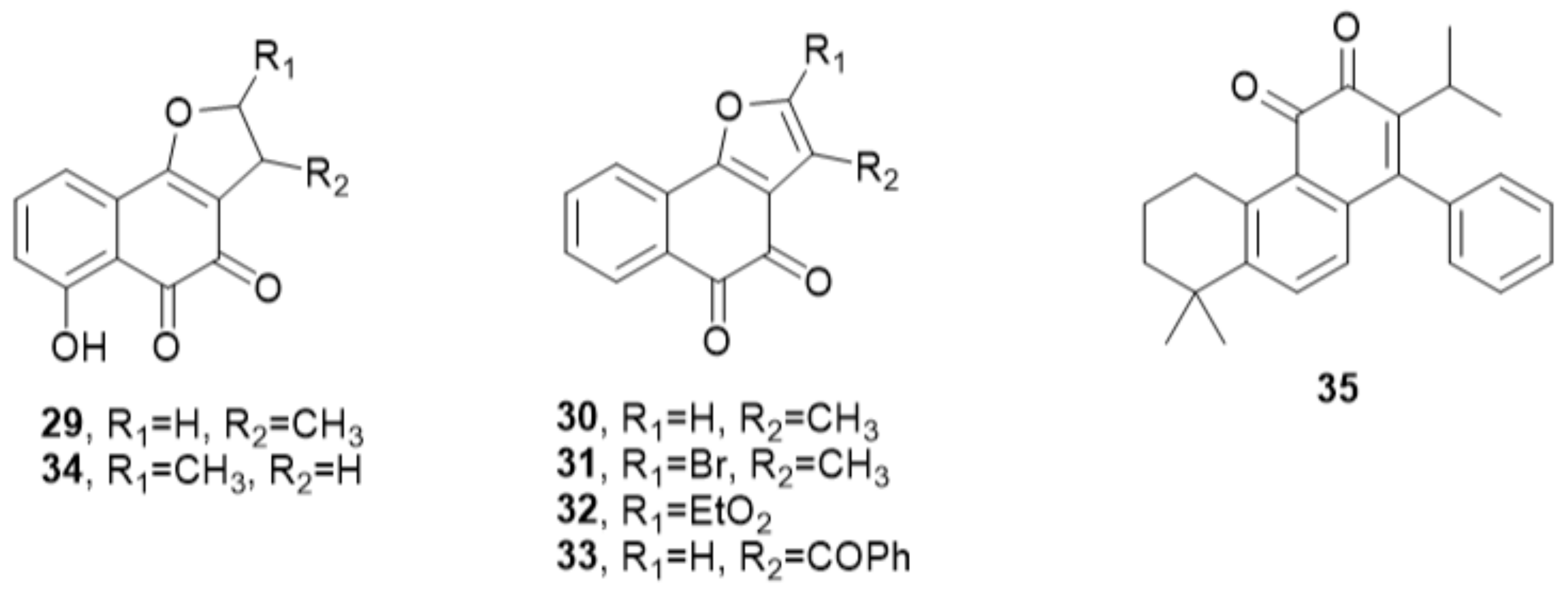
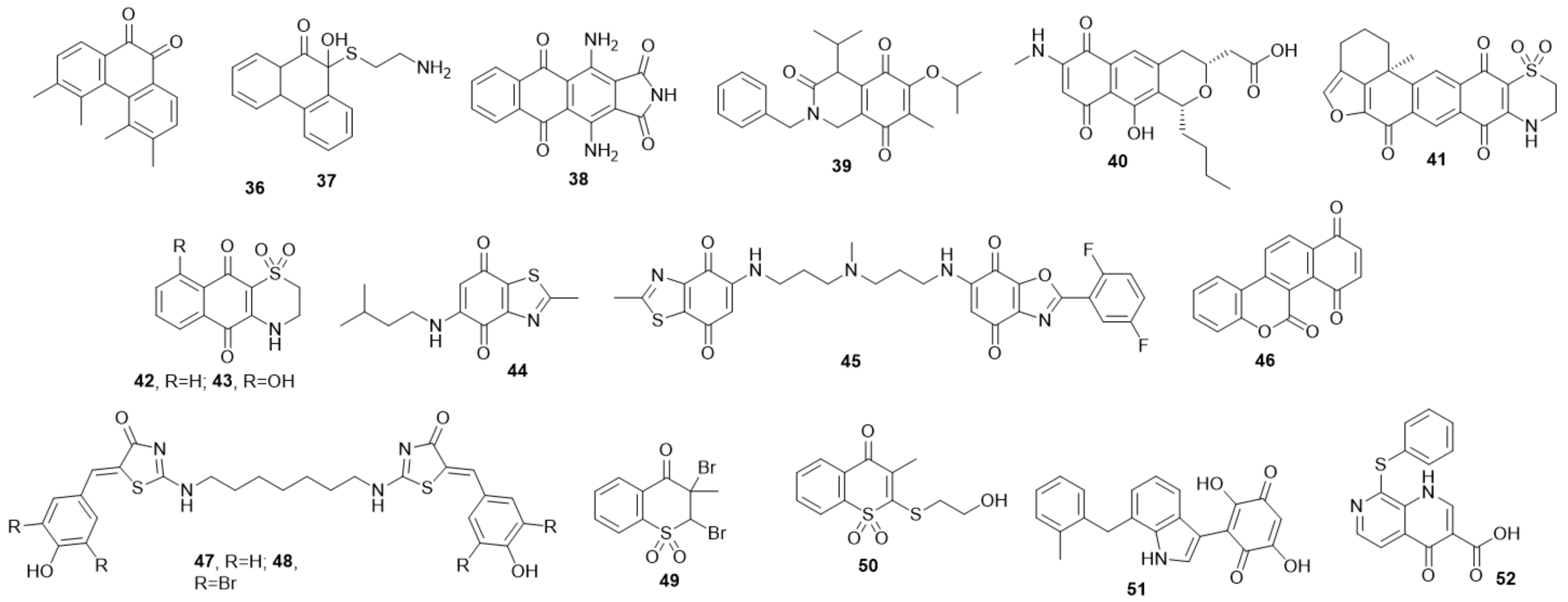

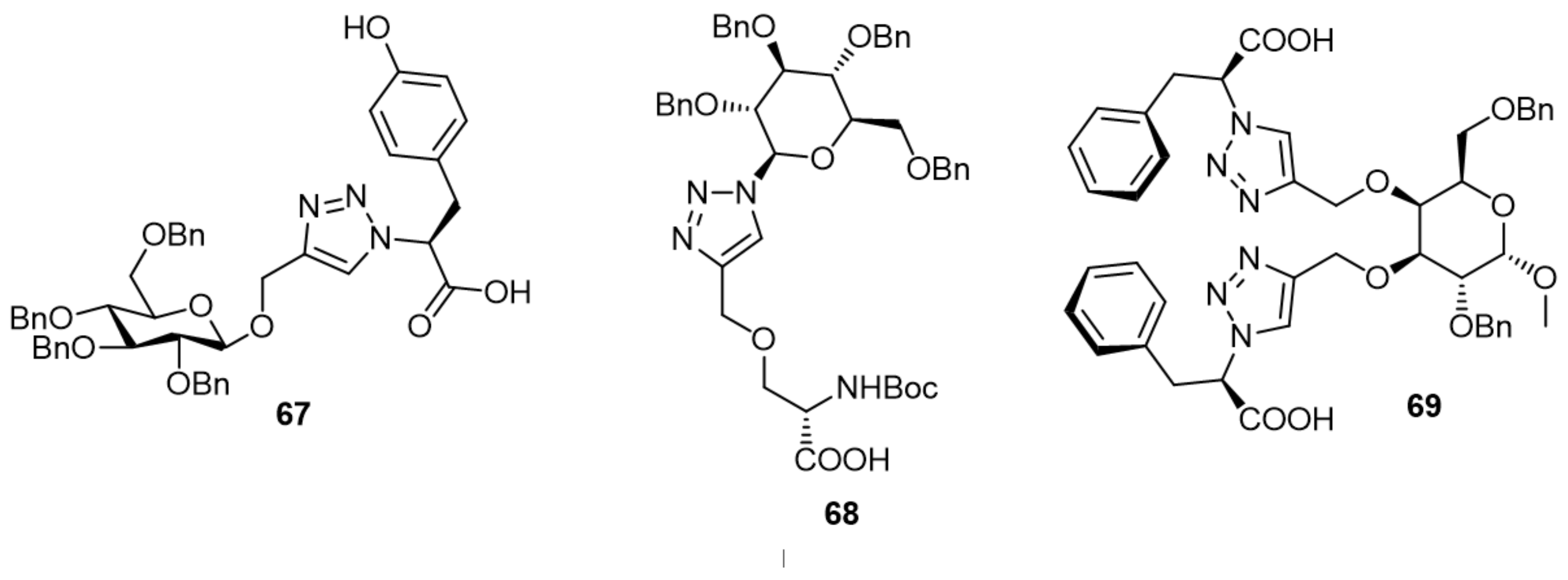
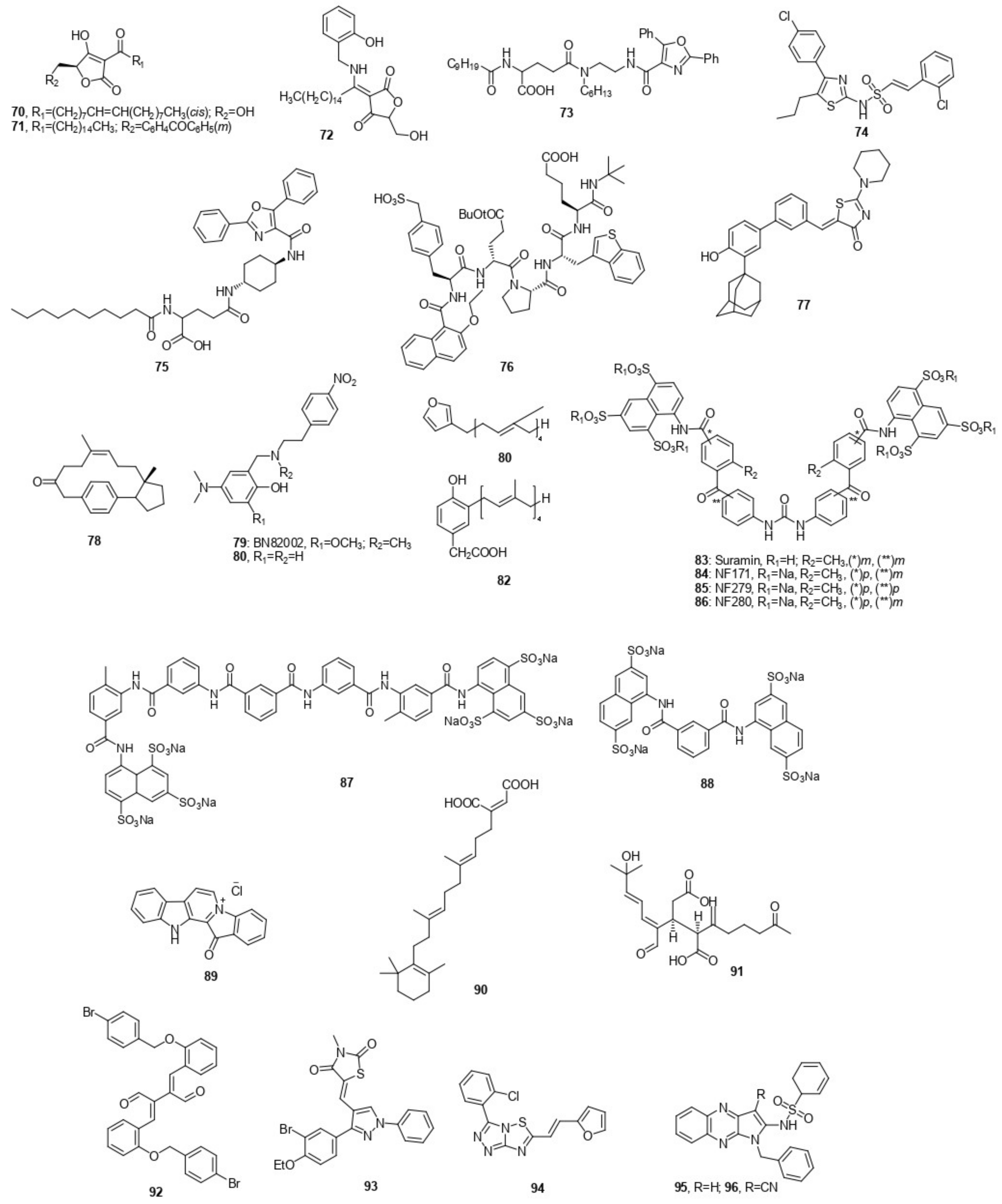
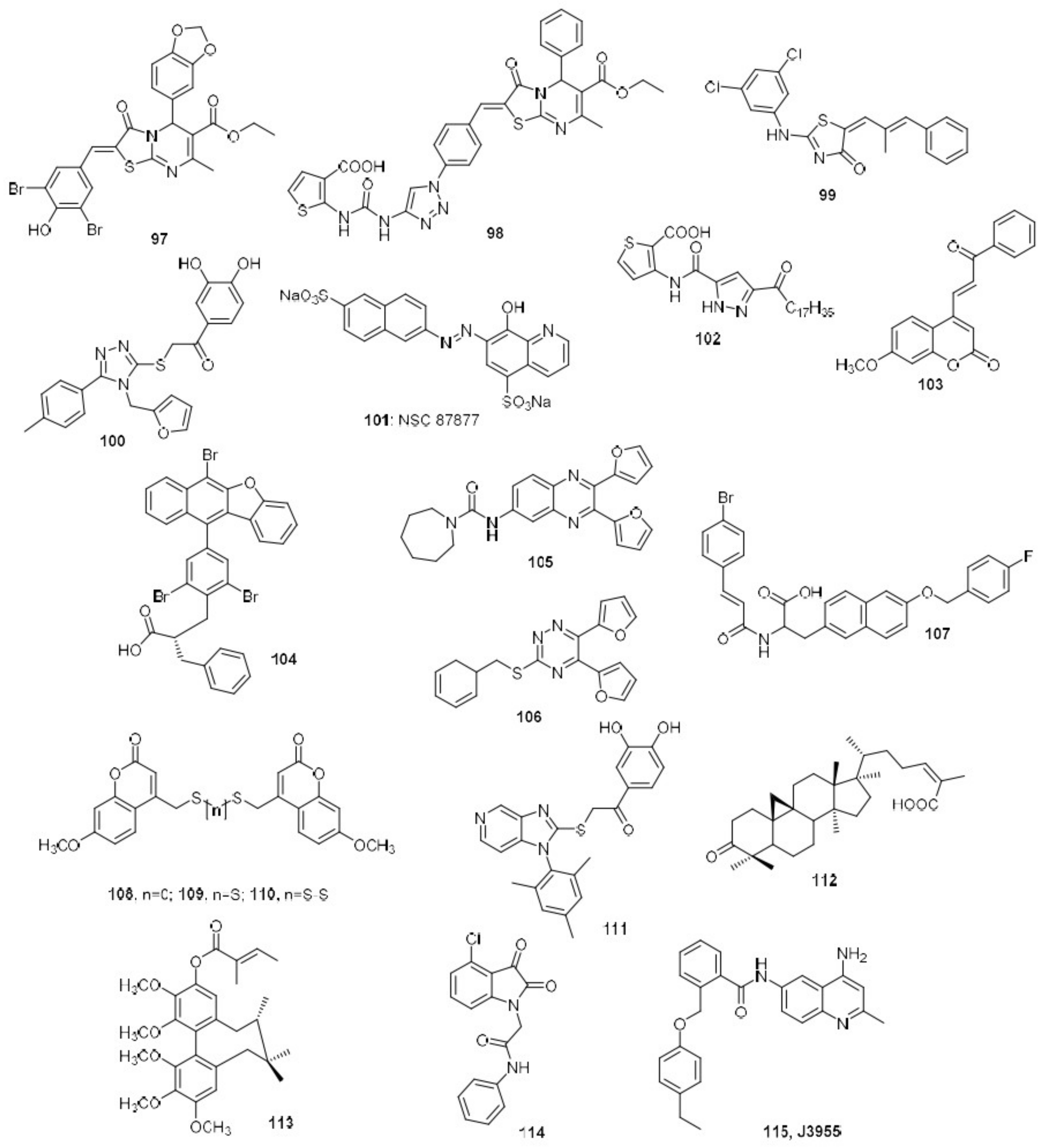
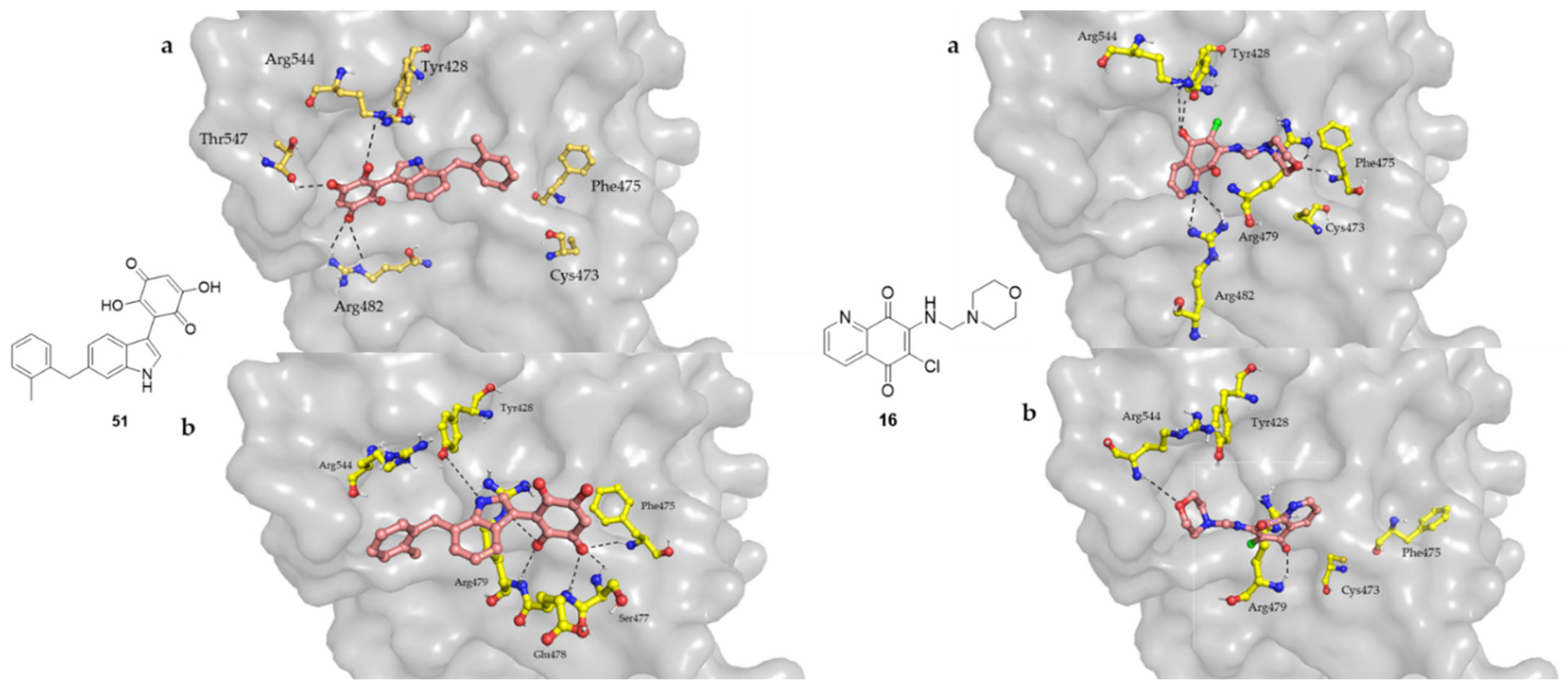

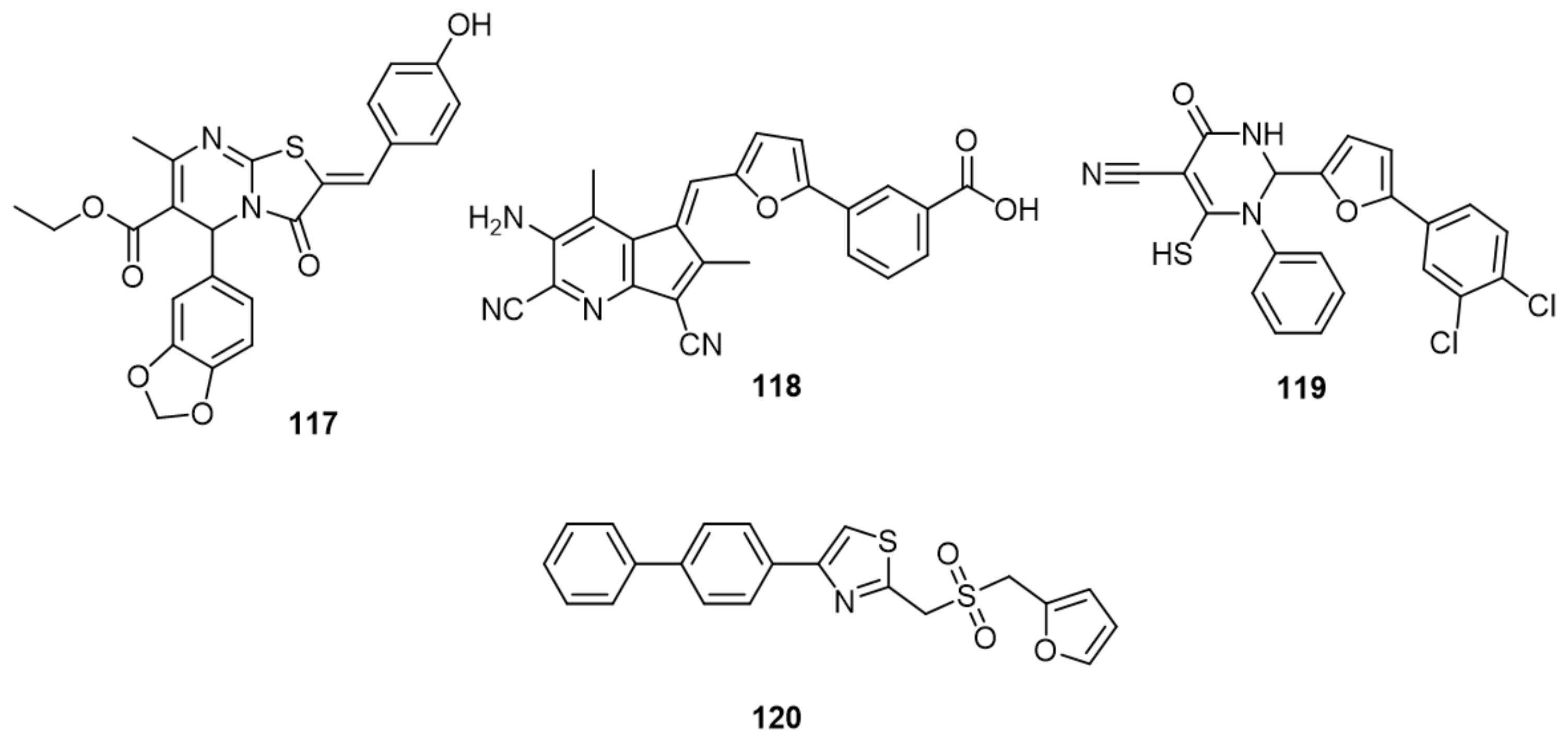
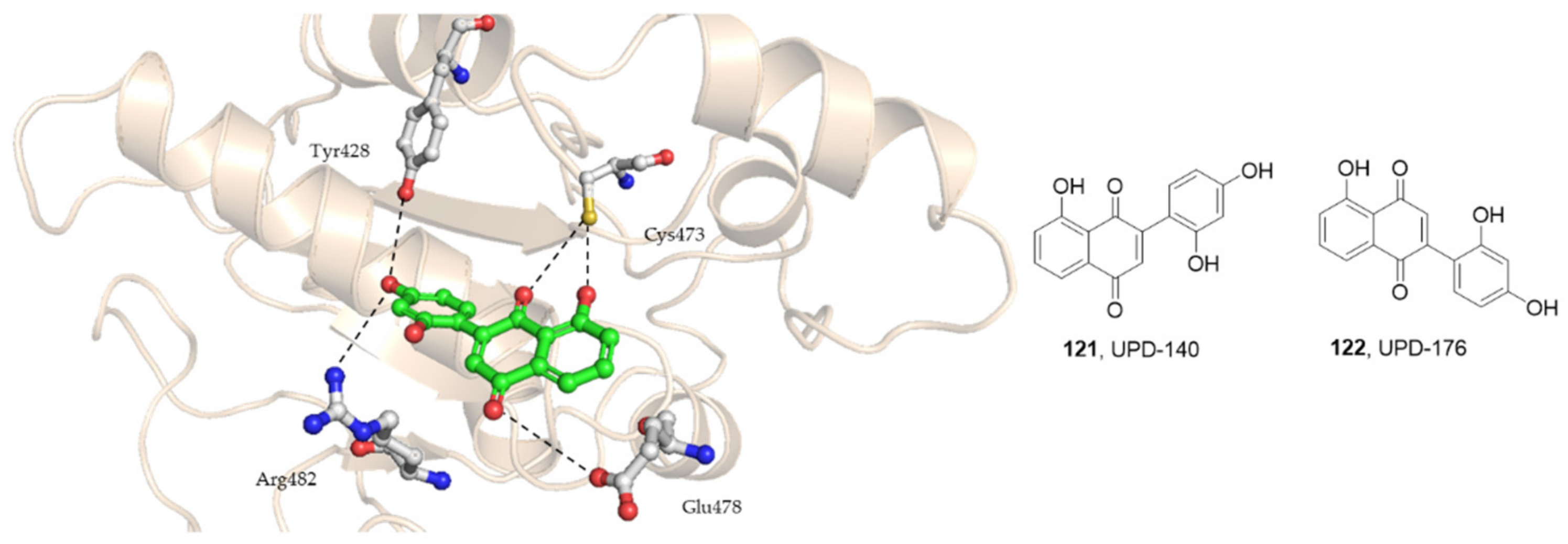
| ID | Cdc25 Inhibitory | Hep-3B | MDA-MB-231 | HTERT-HME1 | HeLa | HepG2 | PLC/PRL/5 | MCF-7 | FemX | LS-140 | SKBR3 | HR | A549 | ||
|---|---|---|---|---|---|---|---|---|---|---|---|---|---|---|---|
| A | B | C | |||||||||||||
| 1 [10,11] | 38 ± 4 | 95 ± 3 | 20 ± 4 | ||||||||||||
| 2 [26,27] | 2 | 2 | 2 | 6.3 ± 0.4 | 15 ± 1 | 12 ± 2 | 12.9 ± 0.3 | ||||||||
| 3 [27] | 2 | 1 | 1 | 10 | 15 | 15 | |||||||||
| 4 [28] | 1.5 | ||||||||||||||
| 5 [28] | 1.5 | ||||||||||||||
| 6 [29] | 1.5 | 20 | |||||||||||||
| 7 [29] | 1.5 | 20 | |||||||||||||
| 8 [30] | 0.022 ± 0.0059 | 0.125 ± 0.006 | 0.0569 ± 0.0177 | 6 ± 0.9 | 10.8 ± 2.9 | 7 ± 0.5 | 6 ± 1 | 10.3 ± 0.4 | 7.59 ± 0.44 | ||||||
| 9 [26] | 1.2 ± 0.2 | 1.5 ± 0.5 | 1.3 ± 0.2 | 1.8 ± 0.5 | |||||||||||
| 10 [27] | |||||||||||||||
| 11 [31] | 0.4 | ||||||||||||||
| 12 [32] | 10.7 ± 0.5 | 12.2 ± 3.7 | |||||||||||||
| 13 [32] | 4.55 ± 0.16 | 51.3 ± 4.1 | |||||||||||||
| 14 [33] | 1/17 ± 0.04 | ||||||||||||||
| 15 [34] | 9.1 ± 0.7 | 9.1 ± 0.7 | 0.9 ± 0 | 9.5 ± 1.0 | 18.1 ± 1.3 | 11.2 ± 0.7 | |||||||||
| 45.5 ± 8 C-cata | 45.5 ± 8 C-cata | ||||||||||||||
| ID | Cdc25 Inhibitory | A549 | HeLa | SBC-5 | U937 | PC-3 | MDA-MB-435 | HCT-116 | ||
|---|---|---|---|---|---|---|---|---|---|---|
| A | B | C | ||||||||
| 29 [43] | 3.21 ± 0.76 | 2.07 | ||||||||
| 30 [44] | 0.73 ± 0.1 | 0.65 ± 0.09 | 1.66 ± 0.13 | |||||||
| 31 [44] | 0.73 ± 0.04 | 0.48 ± 0.03 | 3.14 ± 0.13 | |||||||
| 32 [44] | 1.10 ± 0.11 | 0.89 ± 0.07 | 2.80 ± 0.2 | |||||||
| 33 [45] | 5.0 ± 0.1 | 10.4 ± 0.1 | 8.8 ± 0.1 | 6.5 | 1.2 | |||||
| 34 [46] | 17 | 0.38 | 0.54 | 6.25 | ||||||
| 35 [47] | 3.96 ± 0.63 | 3.16 ± 0.22 | 4.11 ± 0.40 | 6.24 ± 0.17 | 6.26 ± 0.12 | |||||
| ID | Cdc25 Inhibitory | A-549 | P388 | SBC-5 | HL60 | PLC\PRF5 | Hep3B | McH7777 | JM-1 | HepG2 | ||
|---|---|---|---|---|---|---|---|---|---|---|---|---|
| A | B | C | ||||||||||
| 53 [62,63,64] | 9.4, 35 | 87 | 4.7 | 1.5 | 5.4 | 7.1 | ||||||
| 54 [62,65,66] | 2.2 | |||||||||||
| 55 [64] | 15 | 19 | 16 | 13.1 | ||||||||
| 56 [64] | 13 | 18 | 1.3 | 1.0 | ||||||||
| 57 [67] | 7.9 | |||||||||||
| 58 [68] | 0.8 | |||||||||||
| 59 [69] | 7.7 | 47 | ||||||||||
| 60 [70,71] | 0.48 | 1.44 | ||||||||||
| 61 [70,71] | 0.7 | 3.7 | ||||||||||
| 62 [72] | 1.9 ± 1.0 | |||||||||||
| 1.6 ± 0.2 | ||||||||||||
| 63 [73,74] | 5.1 ± 0.3 | 3.6 ± 0.4 | 4.3 ± 1.1 | |||||||||
| 64 [73,74] | 4.5 ± 1.7 | 6.7 ± 0.6 | 8.8 ± 1.3 | |||||||||
| 65 [75] | 3 | |||||||||||
| 66 [76] | 1 | 1 | 10 | 0.5 | 1 | 1 | 1 | 3 | ||||
Publisher’s Note: MDPI stays neutral with regard to jurisdictional claims in published maps and institutional affiliations. |
© 2022 by the authors. Licensee MDPI, Basel, Switzerland. This article is an open access article distributed under the terms and conditions of the Creative Commons Attribution (CC BY) license (https://creativecommons.org/licenses/by/4.0/).
Share and Cite
Abdelwahab, A.B.; El-Sawy, E.R.; Hanna, A.G.; Bagrel, D.; Kirsch, G. A Comprehensive Overview of the Developments of Cdc25 Phosphatase Inhibitors. Molecules 2022, 27, 2389. https://doi.org/10.3390/molecules27082389
Abdelwahab AB, El-Sawy ER, Hanna AG, Bagrel D, Kirsch G. A Comprehensive Overview of the Developments of Cdc25 Phosphatase Inhibitors. Molecules. 2022; 27(8):2389. https://doi.org/10.3390/molecules27082389
Chicago/Turabian StyleAbdelwahab, Ahmed Bakr, Eslam Reda El-Sawy, Atef G. Hanna, Denyse Bagrel, and Gilbert Kirsch. 2022. "A Comprehensive Overview of the Developments of Cdc25 Phosphatase Inhibitors" Molecules 27, no. 8: 2389. https://doi.org/10.3390/molecules27082389






